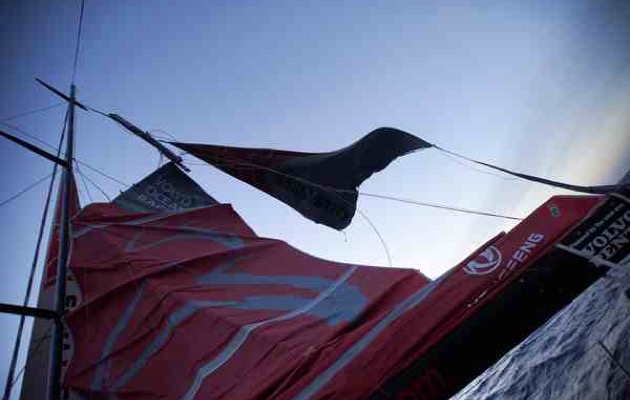Losing their mast has not only cost the Franco/Chinese team points on Leg 5 but is putting pressure on their participation in Leg 6 to Newport
As the rush to rebuild Team Vestas continues following their grounding in the Indian Ocean, the dismasting of Charles Caudrelier’s Donfeng Racing Team in the Southern Ocean last Monday, marks yet another race against time for the Volvo fleet.
Caudrelier’s team lost the top section of their mast at 0315 on 30 April while just a few hundred miles to the west of Cape Horn. They have since managed to limp into Ushuaia to effect repairs and stabilise the remaining section to allow it to be used with a jury rig on both tacks before continuing to the leg finish in Itajai.
While the team would have preferred to sail to the finish and complete the leg, the reality is that motor sailing is the only way that the Franco/Chinese team is going to get to the stopover in Brazil in time and stand any chance of staying in the race. Even then, there is no guarantee that they will be able to make the start of Leg 6 from Brazil to Newport USA.
The start of the next leg is on 19 April, just over two weeks after the fleet was expected to arrive, but the three day delay to the start form Auckland as the race organisers waited for Cyclone Pam, that swept past New Zealand, to abate has put extra pressure on an already tight schedule.
Caudrelier and his team are around 2,000 miles away from Itajai and due to leave on Wednesday evening. Motoring is unlikely to be fast enough to get to Itajai in time, motor sailing is their only option and estimated to take around 10-12 days. Even if they complete the trip in this time, a new mast has to be stepped and the boat prepared for the next leg in just five days – possible but tight.
The knock on effect on the crew is also an issue and a factor that all the teams are acutely aware of. With just eight sailing crew on physically demanding boats, recovery time between legs is crucial. Throughout the race Caudrelier has been rotating various crew, but his core crew has remained the same. Losing valuable days to recover, while at the same time putting all hands to the pumps to get the boat back on the start line, will doubtless take its toll.
And then there’s the competitive issues. Using the engine has forced Caudrelier to accept that he must retire from the leg, a tough blow given that Dongfeng were equal first overall with Ian Walker’s Abu Dhabi. Assuming Walker’s team complete the leg, Dongfeng’s misfortune has handed Walker an eight point advantage.
Finishing last would see Dongfeng take six points rather than eight, better, but to do this would mean having to sail the rest of the leg and would seriously jepordise the following leg.
But while Dongfeng battle to get back into the race, the issue of why the failure occurred is causing some debate. The team has had issues with the mast before during the race, having been forced to repair the mast track twice during racing. Is there a link between these issue s and the subsequent failure? At present we don’t know, but it hasn’t stopped some from asking whether the team is setting up the rig in a different manner from others.
The reports of broken gear aboard the boat throughout the race so far have also raised questions about the way in which the boat is sailed. But the team says that they are simply telling the full story, warts and all, while others may be holding back reports of gear problems.
Whatever the reasons, there is no doubt that this is a big blow to Caudrelier and the Donfeng Race Team. Until this point if a rugby styled ‘man of the match’ was to be awarded it would surely go to this team, a mixture of experience and newbies that has bucked the odds and delivered impressive performances on many occasions.
Given how close the racing is and how resilient this team has proved to be, no one should rule them out, but it remains clear that this is another race against time for a team that wasn’t expecting to stay in the game with the engine on.




